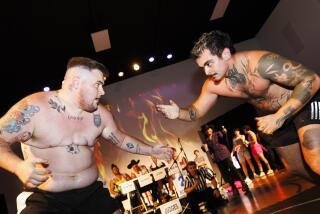Hollywood is ‘in the Sidney Poitier phase of trans representation’ in TV and film
During the fourth season of “The Jeffersons,” the series Norman Lear created as the black spinoff of “All in the Family,” Sherman Hemsley’s character, George, is excited about reconnecting with an old Navy buddy. Knocking on his friend Eddie’s hotel room door, George prepares himself for a trip down memory lane, especially the story of how a drunken night of fun led to the tattoo on Eddie’s right arm. But opening the door is not Eddie. It’s Edie. George’s wartime mate is now a transgender woman. Though George initially couldn’t wrap his head around his old friend’s identity, by the end of the episode, which first aired in October 1977, the two embrace as they did years ago.
Earlier that same year, Lear had written the first transgender character to be featured as a series regular in “All That Glitters,” with Linda Gray as a transgender fashion model. But as groundbreaking as these roles were, they did not mark an immediate sea change. It would be decades before “Orange Is the New Black’s” Laverne Cox was nominated for a 2014 Emmy, followed by Jeffrey Tambor and the Amazon Prime show he leads, “Transparent,” taking home several Emmys this year. Despite the current wave in television of positive stories featuring transgender characters, Hollywood has a long way to go.
See more of Entertainment’s top stories on Facebook >>
“There’s a perception that we are awash in trans characters on television right now,” says Nick Adams, transgender media spokesman for the advocacy group GLAAD. “But as far as I can tell, I only know of about 10 trans characters who’ve been series regulars ever. If I can count on both hands the number of series regulars on TV ever, that’s not very many.”
Reality and perceptions
Reality TV has seen the greatest proliferation of transgender images in the last year, led by former Olympian and Kardashian parent Caitlyn Jenner’s “I Am Cait.” According to Adams and a GLAAD report titled “Where We Are on TV,” reality television represents the transgender experience more broadly than scripted shows.
But the history on which scripted and reality shows stand on isn’t the most politically progressive. GLAAD, which evaluates LGBT representation in TV, film and other disciplines for its annual media awards, says few reality shows have positively featured transgender people. The first year transgender people were meaningfully represented in a number of reality shows was 2008 with “America’s Next Top Model,” “I Want to Work for Diddy” and “Transamerican Love Story” earning GLAAD Media Award nominations. Since 2008, at least one show earning a nomination for outstanding reality program each year has featured a transgender person.
As for scripted shows, GLAAD’s latest report notes that of the 271 regular and recurring LGBT characters on scripted broadcast, cable and streaming programming, only seven (2.6%) are transgender. What’s worse is that nearly half of characters evaluated through 2014 by GLAAD have been “defamatory, stereotypical and can only be described as inaccurate and offensive,” Adams says, with around 35% as “barely acceptable.”
Most of these roles have been one-off story lines on cop or medical dramas in which the transgender person is either a misgendered unnamed dead victim or a sex worker. With this as the foundation that representations of transgender people rest on, Adams sees the recent saturation of trans people on TV positively.
“We need a bandwagon of trans characters to even begin to undo much of the damage that has been done by the way trans people have been presented in the past,” he says.
That bandwagon is well on its way with nearly 10 reality-based shows featuring at least one transgender person this year being eligible for recognition from the media advocacy organization. A sampling of their casts, which include TLC’s “I Am Jazz” and Oxygen’s “The Prancing Elites Project,” reveals trans people from varying backgrounds, races and social status, a “really bright spot in terms of trans people being able to see themselves on TV,” says Adams, who is also a transgender person.
See the most-read stories in Entertainment this hour >>
The picture is dimmer in scripted television. There is only one trans character regularly featured on a broadcast series: “The Bold and the Beautiful’s” Maya Avant played by Karla Mosley.
“That’s not enough to make an impact or portray the diversity of the trans experience,” Adams says.
As is often the case, however, original scripted content from streaming services is both disrupting and improving images normally associated with TV screens, even if ever so slightly. Netflix’s “Orange Is the New Black” was followed by Amazon’s “Transparent” and another Netflix property “Sense8.” All three shows feature transgender story lines and trans actors. Despite their accolades, when added to the limited lot of scripted shows with trans-related stories, what looks like immense progress is quite limited.
Improving the representations of trans people, in number and content, is the next frontier of this early shift taking place in Hollywood.
“We’re still at a point where we’re centering a [particular] narrative a little bit heavier than others,” says Jen Richards, a transgender actress and cast member of “I Am Cait.” “That, not surprisingly, is of those who were straight white men.”
Authentic stories
With increased representation, transgender people are calling for more authenticity in the telling of their stories. Though one would assume reality television would provide the best portrayals, Angelica Ross, a trans actress and activist, sees scripted television as the genre with more authentic trans stories because of reality TV’s reliance on ratings and “the need to create drama to meet the demand,” she says.
“There’s a difference in manipulating characters for advertising dollars,” Ross says, “and being a writer that really is revealing a character’s layers so we connect in a human way.”
Authenticity is the key to “Transparent,” many critics and the trans community have said. According to Zackary Drucker and Rhys Ernst, transgender creatives who first served as consultants for “Transparent” creator Jill Soloway and now are producers on the project, their show’s character traits and story lines come from having transgender (and gender nonconforming) people at virtually every level of the show’s production. Soloway instituted an unofficial hiring practice they call “trans-firmative action” to put as many transgender people as possible in front of and behind the camera.
“At this moment in cultural production, the infrastructure of including trans people in the development of a show is imperative because if you have trans actors playing really troubled, problematic, cis-normatively written characters, it’s doing a disservice to the community,” Drucker says. “It’s paying lip service to including trans people when they’re only being used in a superficial capacity.”
By allowing transgender people to have voices in the creative process, like Drucker and Ernst, who, Drucker says, “shepherd the politics of representation” on the show, Soloway and “Transparent” have become the industry prototype for supporting trans people holistically, not just telling their stories.
This is particularly important as transgender people experience unemployment at twice the rate of the general population, with rates for trans people of color up to four times the national unemployment rate.
‘Sidney Poitier phase’
As for which genre will be most responsible for pushing the country forward, Ernst bets on scripted television because it takes “so much more of an investment in talent and money,” a true demonstration of a person’s commitment to the community and authentic storytelling.
Much as when the gay community began to create products that showcased their experiences when mainstream Hollywood did not, transgender people are beginning to do the same through the Internet. Richards and Ross, for example, costar in a Web series called “Her Story” which focuses on a subject of trans life not yet fully explored in reality television or scripted shows: dating. The series of six 10-minute episodes, available free Jan. 19 after a successful crowd-funding campaign, embodies a “for us, by us” approach to cultural production that, Ross says, “makes space for the nuance of difference in the trans community.” Additionally, having trans people at the helm of their stories ensures that their narratives “get honored instead of exploited,” she says.
Looking forward, Richards sums up what’s needed to improve and round out transgender representations in the media with one word.
“More,” she says. “We just need more, more of everything. Right now we’re in the Sidney Poitier phase of trans representation, where the few that we have have to be so unassailable so that we can open doors. But what’s next is we need our hot messes, our rebels, our sexpots and drama queens. We need representation across the board.”
And for those looking to include trans stories in their shows, Adams encourages them to look to “Transparent” for inspiration.
“Realize that including trans people at every level possible will help make your show better and more authentic,” he says, even for reality shows. “There is certainly a higher expectation now, on the part of the trans community, that shows about us will include us.”
Twitter: @TrevellAnderson
More to Read
The complete guide to home viewing
Get Screen Gab for everything about the TV shows and streaming movies everyone’s talking about.
You may occasionally receive promotional content from the Los Angeles Times.







